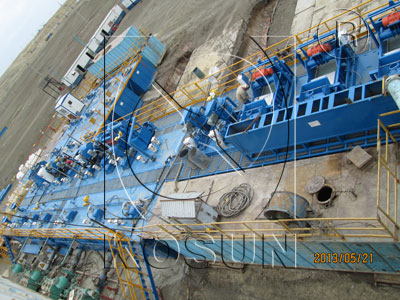Sep 13, 2013
As early as the third century BC, the Chinese were using drilling fluids, in the form of water, to help permeate the ground when drilling for hydrocarbons. The term "mud" was coined when at spindle top in the US, drillers ran a herd of cattle through a watered-down field and used the resulting mud to lubricate the drill.
While the technology and chemistry of drilling fluids have become much more complex, the concept has remained the same. Drilling fluids is essential to drilling success, both by maximizing recovery and minimizing the amount of time it takes to get the first oil.
Functions of Drilling Fluids
The main functions of drilling fluids include providing hydrostatic pressure to prevent formation fluids from entering into the well bore, keeping the drill bit cool and clean during drilling, carrying out drill cuttings, and suspending the drill cuttings while drilling is paused and when the drilling assembly is brought in and out of the hole. The drilling fluids used for a particular job is selected to avoid formation damage and to limit corrosion.
During drilling, cuttings are obviously created, but they do not usually pose a problem until drilling stops because a drilling bit requires replacement or another problem. When this happens, and drilling fluids are not used, the cuttings then fill the hole again. Drilling fluids are used as a suspension tool to keep this from happening. The viscosity of the drilling fluids increases when movement decreases, allowing the fluids to have a liquid consistency when drilling is occurring and then turn into a more solid substance when drilling has stopped. Cuttings are then suspended in the well until the drill is again inserted. This gel-like substance then transforms again into a liquid when drilling starts back up.

Drilling fluids also help control pressure in a well by offsetting the pressure of the hydrocarbons and the rock formations. Weighing agents are added to the drilling fluids to increase its density and, therefore, its pressure on the walls of the well.
Another important function of drilling fluids is rock stabilization. Special additives are used to ensure that the drilling fluids is not absorbed by the rock formation in the well and that the pores of the rock formation are not clogged.
The longer the well is, the more drill pipe is needed to drill the well. This amount of drill pipe gets heavy, and the drilling fluids adds buoyancy, reducing stress. Additionally, drilling fluids helps reduce friction with the rock formation, reducing heat. This lubrication and cooling helps prolong the life of the drilling bit.
Solids control is a technique used in drilling rig to separate the solids in the drilling fluids that are crushed by the drilling bits and carried out of the well surface. Quality solids control of drilling fluids is a key part of the drilling process. Normally, solids control system is consisted of five stages, including mud tank, shale shaker, vacuum degasser, desander, desilter, centrifuge. Shale shaker is used to separate the big solids with diameter above 75μm, and 45~74μm for desander, and 15~44μm for desilter. Sometimes desander & desilter are combined as highly efficient mud cleaner. When air enters into the drilling fluids, vacuum degasser is used to separate the air. If no air is found in the mud, the degasser can work as a big agitator. All these equipment are mounted on the top of the mud tank. After separating the solids, the clean mud will be pumped into the borehole again.